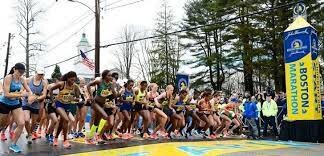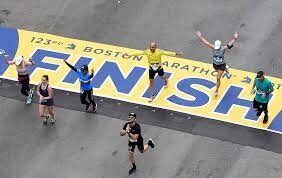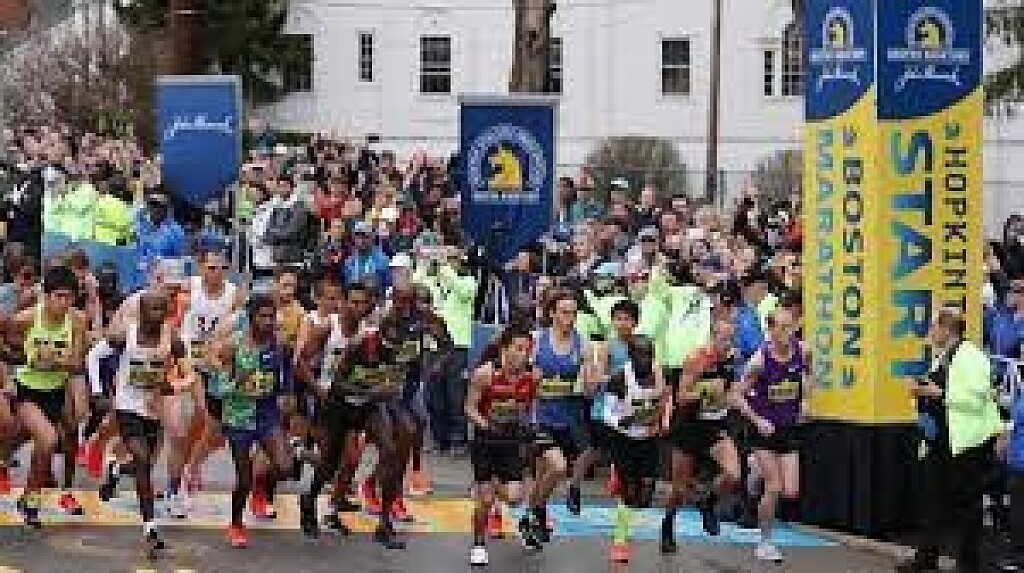Running News Daily
Running News Daily is edited by Bob Anderson. Send your news items to bob@mybestruns.com Advertising opportunities available. Train the Kenyan Way at KATA Kenya and Portugal owned and operated by Bob Anderson. Be sure to catch our movie A Long Run the movie KATA Running Camps and KATA Potato Farms - 31 now open in Kenya! https://kata.ke/
Index to Daily Posts · Sign Up For Updates · Run The World Feed
How to Qualify for the Boston Marathon
So you want to qualify for the Boston Marathon? You’re not alone. As an age-group or recreational runner, it’s one of the noblest (and most common) goals to set your sights on.
The history and prestige of the Boston Marathon are unparalleled in the world of running, which is why getting the opportunity to run the famed 26.2-mile route from the start in Hopkinton to the finish line on Boylston Street in downtown Boston is a top-shelf bucket list goal for many runners.
And rightly so. With the challenge it requires to qualify, the experience of running Boston is all that and more.
6 Tips on Qualifying for Boston

For most age-group runners, qualifying for Boston isn’t a simple task. Every athlete’s journey to trying to earn a Boston-qualifying time (BQ) is unique, and your approach needs to be specifically catered to who you are as a runner. And, like with all things running, there are no shortcuts for earning a BQ—but there are some key points to consider on your quest.
1. State Your Intention.
If you’re truly interested in qualifying for Boston, it’s a good idea to make it one of your primary goals (both in running and in life) so you can focus as much energy as possible toward it and take a smart and healthy approach to achieving it. That doesn’t mean you have to post it on Instagram, but it’s something you should share with your significant other, family members, and running buddies to generate long-term excitement and support as well as keeping you accountable on your journey.
Every age group has a different qualifying time that needs to be attained in a two-year window prior to registration opening in the fall prior to the next race the following April. For women, the age groups and times are:

18–34: 3:30.00 (3 hours, 30 minutes, and zero seconds)
35–39: 3:35.00
40–44: 3:40.00
45–49: 3:50.00
50–54: 3:55.00
55–59: 4:05.00
60–64: 4:20.00
65–69: 4:35.00
70–74: 4:50.00
75–79: 5:05.00
80 and over: 5:20.00
Men
18-34: 3 hrs 00 min 00 sec
35-39: 3 hrs 5 min 00 sec
40-44: 3 hrs 10 min 00 sec
45-49: 3 hrs 20 min 00 sec
50-54: 3 hrs 25 min 00 sec
55-59: 3 hrs 35 min 00 sec
60-64: 3 hrs 50 min 00 sec
65-69: 4 hrs 5 min 00 sec
70-74: 4 hrs 20 min 00 sec
75-79: 4 hrs 35 min 00 sec
80 & over: 4 hrs 50 min 00 sec
There’s also the added complication that just hitting the time doesn’t guarantee entry to the race. Runners typically need to also meet faster cut-off times if registration exceeds the race capacity (see tip #6).
“It’s a great goal and a very relevant goal for a lot of a marathoners,” says New York City–based running coach Elizabeth Corkum. “When it’s your first Boston, it’s a big deal and definitely something you should be excited about.”
2. Set a Realistic Goal
For many runners, it takes a full year or two—or maybe even five or more—to develop the aerobic strength and overall fitness to be in position to reach the qualifying time in your age group.
The first step: Understand that the path to running fast enough to earn a BQ standard isn’t a quick process of instant gratification.
“A lot of runners will come to me and say I want to qualify for Boston this year because a lot of runners are always eager to do it now, but the reality is that it might take a few years,” says Chicago-area coach Jenny Spangler, who won the 1996 U.S. Olympic Trials Marathon. “It’s a great goal for many people, but it’s a commitment and you have to be realistic about where you are and where you need to get. For some runners, it will take a while. Sometimes I’ll have runners aim for running a fast half marathon first and then next year start to focus on a fast marathon.”
If you’re serious about qualifying for Boston, it’s best to connect with a coach or local training group that has a history of helping runners achieve a BQ. You’ll want to find a coach who will take into consideration both your history as a runner and as an athlete as well as your current fitness level, previous races, monthly mileage volume, injury history, and, perhaps most important, your ability to commit to a complicated training program amid your work-life balance.
“You don’t like to discourage anyone, but a Boston qualifying time is hard,” Spangler says. “So for people who can’t commit the time for training or maybe just don’t enjoy running or don’t want to put in the mileage, it might not be possible. It’s a commitment and it’s just not for everybody.”
3. Pick a Qualifying Race
One of the keys to qualifying for Boston is running a fast, USATF-certified course with a high probability of running your goal time. Typically, the races with the most qualifiers are the New York City Marathon and the Chicago Marathon, and, of course, Boston itself, but that’s largely based on the volume of runners in those races. However, those marathons can be hard to get into, so unless you already secured an entry, you should plan on another race with a high propensity of Boston-qualifying times.
One of the best options is the California International Marathon (CIM), where 25 to 35 percent of the field typically earns a BQ. The only challenge about qualifying at CIM is that it’s held the first Sunday in December, so you’ll have to wait and enter for the next Boston Marathon 16 months later.
Another great option among mid-sized races is the mid-June Grandma’s Marathon in Duluth, Minnesota, which typically has both a large number of qualifiers and a relatively high percentage of BQers. In 2019, 1,108 of its finishers (18.2 percent) earned BQ qualifiers. From 2010-2021, an average of 15.8 percent of Grandma’s finishers earned BQ times.
“Usually when people come to me, they already know which race they want to run,” says Nell Rojas, a Boulder, Colorado–based professional runner for Adidas who also coaches age-group runners. “But if not, I usually recommend California International Marathon or Grandma’s Marathon, which are fast marathons that are easy to get into with a lot of people that will be running their same speed. And that’s key because that means there will be people to run with at the pace you want to run the whole way.”
Since 2017, some of most prevalent qualifying races have been “last chance” races designed to get runners qualified right before the opening of Boston registration in mid-September. The Last Chance BQ.2 race in Grand Rapids, Michigan, has had an average of about 60 percent BQ’ers every year since 2015, while its sister event, Last Chance BQ.2 race in Geneva, Illinois, has typically had at least 50 percent of its field qualify. But both of those races are small, usually 350 runners, and registration fills up fast every spring. (The Geneva race added a spring race in 2018 and it has also typically had a 50 percent qualifying rate.)
Other small, early September races with high BQ percentages include the Erie Marathon at Presque Isle (Erie, Pennsylvania), Via Marathon (Allentown, Pennsylvania), and Tunnel Light Marathon (North Bend, Washington). A few key marathons with downhill profiles and high qualifying percentages are the St. George Marathon (St. George, Utah), Revel Big Bear Marathon (Big Bear, California), and Mountains 2 Beach Marathon (Ojai, California). Cities with mid-sized marathons that are known to have good courses for qualifying: Philadelphia; Indianapolis; Houston; Eugene, Oregon; and Santa Rosa, California.
4. Get Some Super Shoes
If you’re interested in maximizing your race-day performance, then you should consider investing in a pair of shoes enhanced with carbon-fiber plates. Yes, they’re expensive, ranging in price from $180 to $275, but the technology works—and can give you 3 to 6 percent advantage over shoes with typical foam midsoles. Nike, Adidas, Skechers, ASICS, On Brooks, HOKA, New Balance, and Saucony all make super shoes, and some of their models are among the best. But each fits and feels slightly different, so visit a local running store, if possible, and try on several pairs before buying.
“Super shoes definitely allow you to run faster,” says ASICS-sponsored pro Emma Bates, who was second at the 2021 Chicago Marathon in 2:24:20 wearing a pair of ASICS Metaspeed Sky. “I love them because they’re so comfortable, but the biggest thing is that I feel that I can recover so much quicker after a workout or a race. After Chicago, I felt like I could do a workout the next weekend. That’s insane. I love the shoes and would never imagine running in anything else ever again.”
5. Train Methodically and Consistently
Going through significant training adaptations is a key part of the process for most runners, especially if they’re new to the sport or don’t have a lot of experience with the various types of workouts in most marathon build-ups. Progress occurs based on how well you handle training volume, how much you recover, and how much time and focus you put toward non-running elements like strength work, nutrition, and rest.
“All of those things factor into how you’re going to direct someone to get to that goal, and it’s different for everyone, for sure,” Corkum says. “Some people have all the time in the world to train and that’s fantastic because we can probably stress their bodies a little bit more with training, knowing that they can rebound. But someone who is only able to sleep four hours a night and has a newborn at home, they already have that additional stress so they have to be careful about adding training stimulus so they don’t get injured or burn out.”
Most coaches recommend going through a 16-week training plan to build up to a marathon, though it could be shorter if you’re already pretty fit or longer if you need more time to get used to the rigors of high-mileage running. A good plan will include periodized segments that include two to three weeks of gradual building of aerobic fitness followed by a slightly relaxed week to allow for recovery and the training adaptations to take place.
Depending on your background and fitness, you’re likely going to be running between 50 and 80 miles per week during the peak weeks of your training plan, Rojas says. While pro runners run between 100 and 120 miles per week, she warns that excessive running volume for age-group runners can lead to fatigue, burnout, and injuries.
A training plan should include a once-a-week long run, one or two faster workouts like a tempo run or an interval session, and several recovery runs. As the training plan progresses, there will be a greater emphasis on up-tempo workouts and your long runs will approach 18 to 22 miles and start getting faster.
But even if you’re following a plan that’s the same or very similar to your running partner’s, your quest to reach a Boston qualifying time will be an individual one.
“Runners come from all different levels of fitness,” Rojas says. “It all depends on what a runner can handle, what their strengths are, what their weaknesses are.”
Spangler says most age-group runners who come to her for help in achieving a Boston qualifier typically need more mileage than intensity in their training, but sometimes it’s both. In addition to ramping up mileage gradually, she’ll sprinkle in spicier workouts like fartlek intervals or hill repeat sessions—as much as she thinks an athlete can handle.
She’ll also prescribe periodic longer tempo runs of 8 to 10 miles at marathon race pace and often have them race a half marathon midway through their training program as a way to gauge a runner’s fitness and boost confidence.
“You can just kind of see how they’re starting to handle workload hitting the paces of the workouts they’re doing and feeling good doing it,” Spangler says. “That’s when you start to get a sense that they’re going to be ready, and that’s when I start getting confident they’re ready to handle the marathon at that pace.”
6. Don’t Get Discouraged
Even if you’re well trained and in the best shape of your life, you need everything to go right on a race day to run your best. Achieving a Boston Marathon–qualifying time can take several years and, if you miss it once or twice, it can start to feel like a never-ending process. Unfortunately, even when you achieve the time, you still might not be able to run the race. Because of field size limitations and increased interest, runners usually need to also meet faster cut-off times than the time listed in tip #1 to get in.
While every runner who applied for the 2022 race was granted entry—likely because of a downturn in interest because of the still-lingering COVID-19 pandemic—in the previous 10 years runners needed to be 1 minute, 2 seconds to 7 minutes, 47 seconds faster than their qualifying time to get in. Depending on the year and the volume of qualified runners, that’s meant that the BAA has had to reject between 1,947 and 9,215 qualified runners.
“It’s such a tough thing and to recreational runners, I think it’s a bit jarring because they’re not used to that,” Corkum says. “One of the beautiful things about Boston is that it’s one of those few marathons where you can’t just send in your credit card number and know that you have it on your calendar. You have to earn it. But the other side of that is the emotional investment and highs and lows that you’re accepting along with it.”
Developing an indefatigable sense of optimism and a love for running will be helpful in your quest to qualify for the Boston Marathon and eventually running it. There will be plenty of hiccups along the way (missed workouts, injuries, life events) so it’s best to make it part of the fabric of your life and not merely a box to check off, Corkum says.
“Running is a patient person’s sport and I think that’s why you really have to love it,” Corkum says. “I think some people might not necessarily love running but they love the idea of achieving ‘that thing,’ and you have to realize there are so many hours and steps that go into making it a lifelong thing, and for a lot of us it becomes that.”
by Brian Metzler
Login to leave a comment
Boston Marathon
Among the nation’s oldest athletic clubs, the B.A.A. was established in 1887, and, in 1896, more than half of the U.S. Olympic Team at the first modern games was composed of B.A.A. club members. The Olympic Games provided the inspiration for the first Boston Marathon, which culminated the B.A.A. Games on April 19, 1897. John J. McDermott emerged from a...
more...




